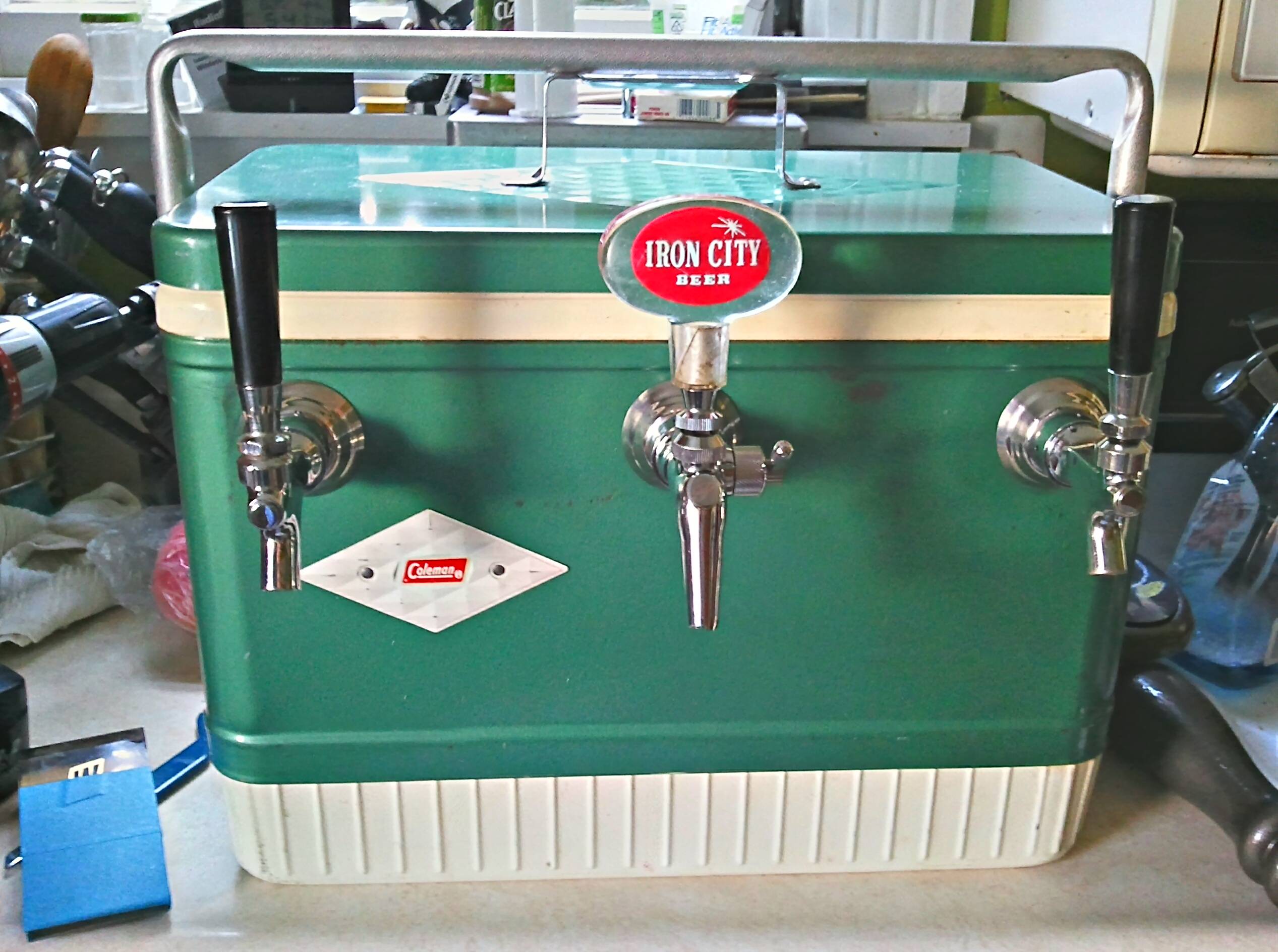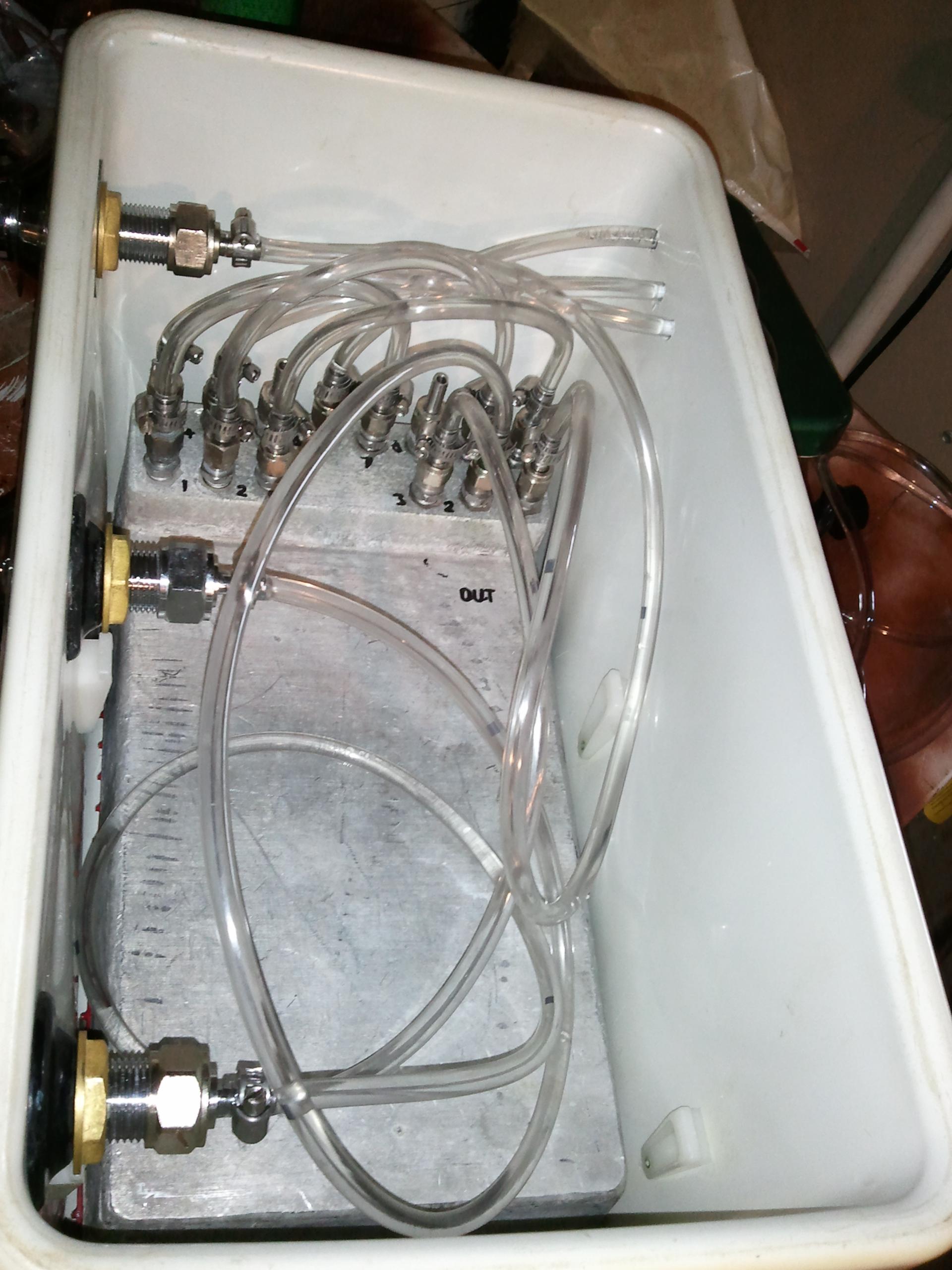stack
Well-Known Member
About a month ago I built a jockey box with a seven circuit cold plate. I only attached three faucets so I am making two passes through the cold plate for each one. All of my lines are 3/16". I would say the lines from the keg to the cold plate are around 8'. Then two passes through the cold plate. I have no idea how long each pass is. Then about 2' or so between the faucet and the cold plate, just enough that I can set the cold plate out of the cooler without disconnecting any lines.
The first time using it was 95 degrees outside. I had the kegs iced and the beer poured extremely cold. I was however having issues with foaming. I would get about one second of foam as soon as the tap was opened, then it would pour great for about 8 ounces or so, then back to foam. I tried both lowering and increasing the CO2 pressure anywhere from 8 to 25 psi with the same results. Aside from the foam it worked great at serving the beer cold.
I decided to test it out again earlier this week. I tried with a room temp keg that was slightly under carbonated, same results. I also tried with a cold, properly carbonated keg that was pouring perfectly out of my kegerator, same results. C02 pressure was adjusted starting at 12 psi all the way up to 35 psi. It seems to work best at around 20 psi, but the foaming problem was still there. I was watching through the clear tubing when the foam was initiated. It seems the initial bit of foam when the faucet is first opened I cannot trace. The second bit seems to be coming from bubbles being formed in the line between the keg and the jockey box. As these bubbles enter the cold plate they must be causing a tremendous amount of turbulence as when the beer comes out of the first pass it can be clearly seen as all foam. I thought that maybe I had a leak somewhere so I retightened all the clamps in the system, none of them were loose. It appears that CO2 may be coming out of solution where the hose is warm, between the keg and jockey box. I have used other jockey boxes, both plate and coil, where the kegs where at room temperature and there was no issue with CO2 coming out of solution.
I am really struggling with how to diagnose and correct my problem.
(edit) I have tried a number of different faucets also, a standard cheapo, Perlick 525, Perlick 425, & even a flow control Perlick. All faucets yielded the same results, FOAM.
I am getting ready to leave for a week at the beach in two days and was considering taking it with me along with three 5 gallon kegs. I am now debating if I should even bother with it if all I am going to end up with is foam. 3 kegs, the cooler and co2 tank is quite a bit of extra weight to haul 500 miles each way.
If anyone has any suggestions / theories on my issue please let me know.
Here are some more pics of my setup.


The first time using it was 95 degrees outside. I had the kegs iced and the beer poured extremely cold. I was however having issues with foaming. I would get about one second of foam as soon as the tap was opened, then it would pour great for about 8 ounces or so, then back to foam. I tried both lowering and increasing the CO2 pressure anywhere from 8 to 25 psi with the same results. Aside from the foam it worked great at serving the beer cold.
I decided to test it out again earlier this week. I tried with a room temp keg that was slightly under carbonated, same results. I also tried with a cold, properly carbonated keg that was pouring perfectly out of my kegerator, same results. C02 pressure was adjusted starting at 12 psi all the way up to 35 psi. It seems to work best at around 20 psi, but the foaming problem was still there. I was watching through the clear tubing when the foam was initiated. It seems the initial bit of foam when the faucet is first opened I cannot trace. The second bit seems to be coming from bubbles being formed in the line between the keg and the jockey box. As these bubbles enter the cold plate they must be causing a tremendous amount of turbulence as when the beer comes out of the first pass it can be clearly seen as all foam. I thought that maybe I had a leak somewhere so I retightened all the clamps in the system, none of them were loose. It appears that CO2 may be coming out of solution where the hose is warm, between the keg and jockey box. I have used other jockey boxes, both plate and coil, where the kegs where at room temperature and there was no issue with CO2 coming out of solution.
I am really struggling with how to diagnose and correct my problem.
(edit) I have tried a number of different faucets also, a standard cheapo, Perlick 525, Perlick 425, & even a flow control Perlick. All faucets yielded the same results, FOAM.
I am getting ready to leave for a week at the beach in two days and was considering taking it with me along with three 5 gallon kegs. I am now debating if I should even bother with it if all I am going to end up with is foam. 3 kegs, the cooler and co2 tank is quite a bit of extra weight to haul 500 miles each way.
If anyone has any suggestions / theories on my issue please let me know.
Here are some more pics of my setup.




